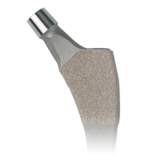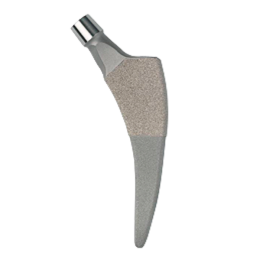Product Description
The multiple families of the Fitmore Hip Stem offer a personalized fit with a bone conserving, curved stem geometry for surgeons who prefer an implant that facilitates smaller incisions. The system aims to provide stable reconstruction of each individual’s anatomy through its innovative concept of matching stem offset with different medial curvatures. The triple taper design and proximal Ti-Plasma coating enables secure press-fit, while the trapezoidal cross-section provides for rotational stability.
The Fitmore system is comprised of three different families, with Family B available in an extended offset option. The families were developed to address the relationship between head center and medial curvature of the femoral canal. Each stem family differs in respect to its medial contour, neck shaft angle, and range of stem offsets.
Bone conservation is an important aspect of total hip arthroplasty. By removing as little bone as possible during a primary operation, the surgeon leaves more option for any potential future revision surgery. The Fitmore Hip’s short curved stem design helps conserve bone.
The Fitmore Hip Stem’s short length and curved design helps preserve the patient’s natural bone in the greater trochanter, where it matters most.
Zimmer has been at the forefront of less invasive approaches to total hip arthroplasty. As the leader in Minimally Invasive Solutions™ procedures, Zimmer is proud to introduce the Fitmore Hip Stem, an implant designed with muscle and soft tissue-sparing approaches in mind.
The Fitmore rasps and implants allow for a curved atraumatic trajectory and insertion along the calcar arch. Through this curved introduction, there is no need to open the lateral trochanter, potentially sparing the insertion point of the hip abductors.
Product Brochure

Indications
This femoral stem is for total or hemi hip arthroplasty and is indicated for the following conditions: Patient conditions of noninflammatory degenerative joint disease (NIDJD), e.g., avascular necrosis, osteoarthritis and inflammatory degenerative joint disease (IJD), e.g., rheumatoid arthritis; those patients with failed previous surgery where pain, deformity, or dysfunction persists; revision of previously failed hip arthroplasty.
Total hip replacements may be considered for younger patients if any unequivocal indiction outweighs the risks associated with the age of the patient and modified demands regarding activity and hip joint loading are assured. This includes severely crippled patients with multiple joint involvement, for whom an immediate need of hip mobility leads to an expectation of significant improvement in the quality of their lives.
This stem is for uncemented use.
Contraindications
Patient's physical conditions that would eliminate or tend to eliminate adequate implant support or prevent the use of an appropriately sized implant, e.g., previous surgery, insufficient quality or quantity of bone resulting from conditions such as cancer or congenital dislocation, metabolic bone disease of the upper femur or pelvis, femoral osteotomy revision, girdlestone revision, osteoporosis, osteomyelitis, neuromuscular compromise or vascular deficiency in the affected limb in sufficient degree to render the procedure unjustifiable (e.g., absence of musculoligamentous supporting structures, joint neuropathy) or other conditions that may lead to inadequate skeletal fixation.
Active infection of the hip, old or remote infection. This may be an absolute or relative contraindication. Every effort should be undertaken to rule out preoperative infection in a patient with suspicious symptoms, such as a history of, or when there are signs of, local inflammation, abscesses, fever, increased blood sedimentation rate, evidence of rapid joint destruction or bone resorption.
Allergy to the implanted material, above all to metal (e.g. cobalt, chromium, nickel, etc.)
Local bone tumors and/or cysts.
Pregnancy.







